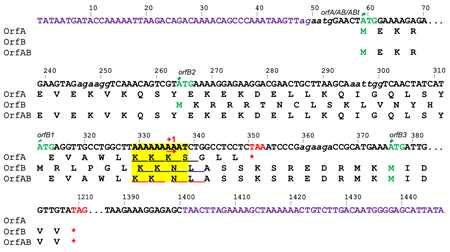(The news is on the webite of our institute)
In nature, the mobile genetic elements in genome are ubiquitous variable DNA sequence. They play important roles in genome plasticity, cell adaptability and function evolution. Bacterial insertion sequences (ISs) are widely used type of genetic elements. ISs of different families and subgroups contain significantly diverse molecular features and functional mechanisms, which are not fully understood.
Recently, the Metabolomics Group fromQingdao Institute of Bioenergy and Bioprocess Technology(QIBEBT), Chinese Academy of Sciences (CAS) detected an active IS3-family transposon IS1447in a typical thermophilic and cellulolytic microorganism,Clostridium thermocellumand analyzed its specific features and frameshifting pattern for transposition.
According to the researchers’ analyses, IS1447-like elements are widely distributed in the Phylum Firmicutes and possess unique features compared with other members of the IS3family. Therefore, IS1447may represent a novel subgroup of the IS3family.
The researchers observed that IS1447exhibits +1 transcriptional slippage to express full-length and functional transposase, which is quite different from other well-known IS3subgroups which perform programmed -1 translational frameshifting. Furthermore, IS1447requires a region of only seven successive adenine nucleotides, instead of previously reported 8 or 9 A or T nucleotides, for frameshift.
“We found that the IS1447-subgroup elements are abundant in the genomes of several cellulolytic bacteria. This implies that they may play roles in bacterial resistance in the complex lignocellulosic environment.” says the corresponding author Prof. Feng of the study, “Meanwhile, it is possible to develop novel genetic tools for thermophiles based on the study of IS1447.”
The related work was published inBiotechnology for Biofuelsand was supported by the “Transformational Technologies for Clean Energy and Demonstration”, Strategic Priority Research Program of the Chinese Academy of Sciences (XDA 21060201), the National Key Technology Research and Development Program of China (2015BAD15B05), the National Natural Science Foundation of China (31570029, 31670735 and 31661143023).

Figure 1. The nucleotide sequence of IS1447. The putative IR sequences are in purple. The putative initiation and termination codons of the transposase(s) are in green and red, respectively. The italic letters in lower case indicate potential ribosome-binding sites. The green arrows above the sequence indicate potential start codons for transposase expression. The potential slippage-prone region is highlighted in yellow, and the reading frames for three types of transposase are underlined in black, blue, and red, respectively.
Publication:
Liu Y-J, Qi K, Zhang J, Chen C, Cui Q, Feng Y. Firmicutes-enriched IS1447 represents a group of IS3-family insertion sequences exhibiting unique +1 transcriptional slippage. Biotechnology for Biofuels. 2018;11:300.